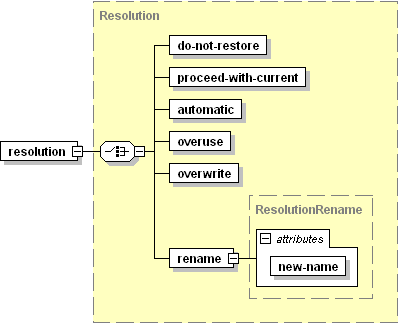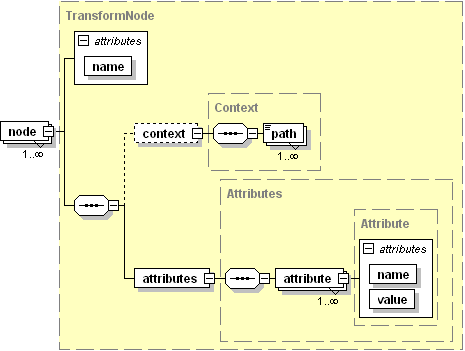Rules
The file should be structured as follows.

-
conflict-resolution-rulesRequired, document root element.-
policyRequired, contains the policies descriptions. For details on the node format, refer to the section Resolutions Description Format: Policies. The element content must reflect the conditions under which the conflicts were detected. -
ruleOptional, contains a rule description.Must be present in the document when defining conflict resolution rules. Should be present as many times as the number of unresolved conflicts.At least one of the attributes (
conflict-id,conflict-guid) MUST be present.-
conflict-idOptional, defines ID of the conflict being resolved. Value is integer. The ID should be obtained from the conflict description returned bypleskrestore(the “/conflicts-description/conflict[@id]” attribute value) -
conflict-guidOptional, defines global ID of the conflict being resolved. Value is string. The GUID should be obtained from the conflict description returned bypleskrestore(the “/conflicts-description/conflict[@guid]” attribute value). If omitted, the conflict for resolution is identified by ID. -
dump-objectsOptional, holds a collection of descriptions of backup objects involved into the conflict and taking the same conflict resolution Must be present in the document in case when different objects involved in the same conflict should be resolved in different ways. May not be present in the document in case when all objects involved in the conflict should be resolved the same way. See the structure below. -
resolutionRequired, contains definition of resolution for the conflict, see the structure below.
-
-
dump-objects structure:

-
nodeRequired, contains a description of backup object involved in the conflict.The element contents must be taken from the conflict description returned bypleskrestore(the “/conflicts-description/conflict/conflicting-objects/node” element).Structured as follows: -
nameRequired, specifies the object type, value must be a string. -
contextOptional, holds a collection of data specifying the object position in backup.-
pathRequired if thecontextelement is present in the document, specifies the location of object definition in the backup metadata. Value must be a string conforming to the XPath notation.
-
-
attributesRequired, holds a collection of the object properties.-
attributeRequired, specifies a particular property of the object (e.g., login, ID, GUID, etc.), empty value.-
nameRequired, specifies the property name, value must be a string. -
valueRequired, specifies the property value, value must be a string.
-
-
resolution structure:

The resolution element must not be empty, it is required that it
contains one, and only one of its children elements:
-
do-not-restoreSets the Do Not Restore resolution for the conflict, empty value. -
proceed-with-currentSets the Proceed With Current resolution for the conflict, empty value. -
automaticSets the Automatic resolution for the conflict, empty value. -
overuseSets the Overuse resolution for the conflict, empty value. -
overwriteSets the Overwrite resolution for the conflict, empty value. -
renameSets the Rename resolution for the conflict, empty value.-
new-nameRequired, specifies a name of unique resource that should be assigned to the conflicting objects, value must be a string. Makes sense only for unique resource usage conflicts (mapping of IP, database server, object owner).
-
